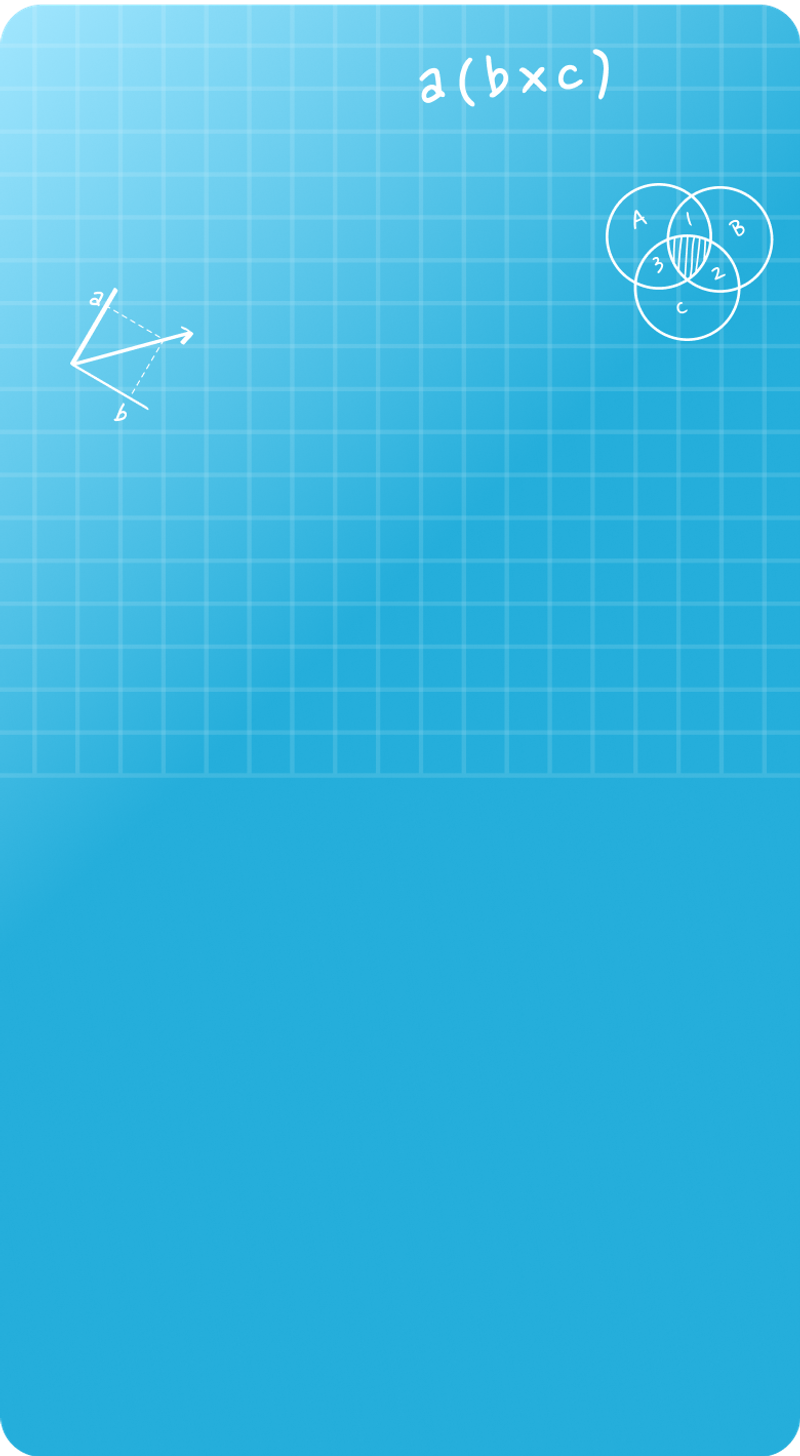
1083 Learners
Geometry
There are an infinite number of shapes in the world, and each shape possesses specific properties that allow us to categorize and study them. Geometry is the branch of mathematics that enables us to study shapes and their properties. Let us learn more about geometry.
Share Post:
Trustpilot | Rated 4.7
1,292 reviews

What is Geometry?
Geometry is a branch of mathematics that deals with the study of size, shape, and physical properties of figures and spaces. It is one of the most important branches of geometry math as it has immense real-life applications in fields such as architecture, construction, art, and engineering.
It also focuses on the study of points, lines, shapes, and spaces, mainly concerning their size, shape, position, and other properties. Plane geometry deals with two-dimensional figures like triangles, circles, and rectangles, while line geometry explores the properties and relationships of lines.
- Point: A point is a precise location in space that has no dimensions, no length, width, or height, making it the most basic element of Euclidean geometry.
- Line: A line is an infinitely long straight path made up of an endless number of points.
- Plane: A plane is a perfectly flat, two-dimensional surface that extends infinitely in all directions.
- Postulate: A postulate is an accepted truth in geometry that does not require proof and helps in forming the basis of geometry formulas and theorems.

History of Geometry
The word geometry is derived from the Greek words, 'geo' meaning earth and 'metron' meaning measure. Geometry is one of the most ancient branches of mathematics. The origins of geometry can be traced back to 3000 BCE, in Greece. From there onwards, there have been constant developments and discoveries in the field of geometry.
Pythagoras: In 530 BCE, Pythagoras introduced the Pythagorean theorem, which explains the properties of right-angled triangles.
Euclid: In 300 BCE, he wrote a systematic compilation of 465 theorems in geometry. It is known as the Euclid’s Element and includes axioms, constructions, and proofs.
Archimedes: In 250 BCE, he discovered methods to calculate the area of circles, the volume of cylinders, and the surface area of spheres.
Similarly, there have been numerous other discoveries ever since 3000 BCE in the field of geometry. The constant developments and evolution of math has made it advanced enough to solve even complex problems.

Major Branches of Geometry
Geometry is broadly classified into several key branches, each addressing specific aspects of shapes and their properties. These branches facilitate a systematic understanding of geometric concepts and are essential in various practical fields such as architecture, engineering, astronomy, design, and technology. These categories make it easier to sort shapes and their properties.
1. Euclidean Geometry: It deals with lines, curves, points, angles, etc. Euclidean geometry is of two types — Plane Geometry and Solid Geometry. It is commonly used in fields like physics, astronomy, navigation, and architecture.
Theorem Example:
Pythagorean Theorem: In a right-angled triangle, the square of the hypotenuse is equal to the sum of the squares of the other two sides.
2. Non-Euclidean Geometry: The axioms given in non-Euclidean geometry are similar to those of Euclidean geometry. However, they have some key differences. Non-Euclidean geometry was developed when mathematicians made changes to Euclid’s fifth postulate (parallel postulate).
Theorem Example:
Angle Sum Theorem for Hyperbolic Triangles: The sum of the angles in a hyperbolic triangle is always less than 180 degrees.
3. Analytical/Coordinate Geometry: It is the study of geometry that uses multiple numbers or coordinates. It gives us accurate positioning of points.
Theorem Example:
Distance Formula: The distance between two points (x1,y1) and (x2,y2) is given by \(\sqrt {(x_2 - x_1)^2 + (y_2 - y_1)^2 }\)
4. Differential Geometry: Another branch of geometry that involves the study of spaces and shapes. It is also the connection between geometry and calculus.
Theorem Example:
Gauss's Theorema Egregium: The Gaussian curvature of a surface is an intrinsic property preserved under local isometry.
5. Projective Geometry: It is used when dealing with the relationships between geometric figures and the images resulting from projecting them onto other surfaces. This is what we refer to as projective geometry.
Theorem Example:
Desargues Theorem: Two triangles are in perspective axially if and only if they are in perspective centrally.
6. Convex Geometry: It studies shapes that remain inside the line segment joining two points. It also has applications in functional analysis and optimization.
Theorem Example:
Helly’s Theorem: For a family of convex sets in Rn, if every n + 1 of them have a point in common, then all the sets have a common point.
7. Topology: Shapes undergoing continuous transformations, such as twisting or stretching, are what we call topology, although no point should be torn apart. Physics, biology, or even computer science are among the few areas where we apply topology.
Theorem Example:
Brouwer Fixed Point Theorem: Any continuous function from a closed disk to itself has at least one fixed point.
8. Algebraic Geometry: It is a branch of geometry that studies zeros of multivariate polynomials. It includes linear and polynomial algebraic equations used for solving sets of zeros. The application of this type encompasses cryptography, string theory, and other related fields.
Theorem Example:
Bezout’s Theorem: The number of intersection points of two algebraic curves in the plane is equal to the product of their degrees, counting multiplicities.
9. Discrete Geometry: It is concerned with the relative position of simple geometric objects, such as points, lines, triangles, circles, etc.
Theorem Example:
Erdős Distinct Distances Theorem: For any finite set of points, the number of distinct distances determined by these points has a lower bound proportional to \(n \over \sqrt{log n}\) for n points.

Important Geometry Formulas
Geometry is an important area of mathematics that focuses on the characteristics and relationship of points, lines, shapes, and solids. The study of these things relies on having a solid understanding of some fundamental ideas that enhance spatial understanding and build important problem-solving skills. These fundamentals can be categorized into five essential areas.
1. Area Formulas: The area measures the amount of surface enclosed within a two-dimensional figure. Here are the most important formulas:
Area of a Rectangle:
Area = L × W (where ‘L’ is the Length and ‘W’ is the Width)
Area of a Square:
Area = S2 (‘S’ is the side of the square)
Area of a Triangle:
A = \(1 \over 2\) (b x h) (where ‘b’ is the Base and ‘h’ is the Height of the triangle)
Area of a Circle:
A = π × r2 (where π can be 3.14 or 22/7 and r is the radius of the circle)
2. Perimeter or Circumference Formulas: Perimeter refers to the total distance around a polygon, while circumference applies specifically to circles:
Perimeter of a Rectangle:
Perimeter = \(2 × (Length + Width)\)
Perimeter of a Square:
Perimeter =\( 4 × Side\)
Perimeter of a Triangle:
\(Perimeter = Side_1 + Side_2 + Side_3\)
Perimeter/Circumference of a Circle:
\(Circumference = 2 × π × radius\)
3. Volume Formula: Volume measures the capacity or space occupied by three-dimensional objects. Some basic formulas are given below:
Volume of a Cube:
\(Volume = Side^3\)
Volume of a Cuboid:
\(Volume = Length × Width × Height\)
Volume of a Sphere:
\(
Volume = \frac{4}{3}× π × radius^3
\)
Volume of a Cylinder:
\(Volume =π × radius^2 × height\)
4. Pythagorean Theorem: The theorem states that the square of the length of the hypotenuse of a right-angled triangle is equal to the sum of the squares of the length of the remaining two sides.
It is expressed as: \(a^2 + b^2 = c^2\).
Where,
'a' is the perpendicular side of the triangle.
‘b’ represents the other perpendicular side of the right-angled triangle.
'c' denotes the hypotenuse.
5. Trigonometric Ratios: We use trigonometric ratios to relate the angles and sides of a right-angled triangle. Below are a few important trigonometric ratios that are commonly used:
sin(θ) = \(Opposite \over Hypotenuse\)
cos(θ) = \(Adjacent \over Hypotenuse\)
tan(θ) = \(Opposite \over Adjacent \)
cosec (θ) = \( Hypotenuse \over Opposite\)
sec (θ) = \( Hypotenuse \over Adjacent\)
cot (θ) = \(Adjacent \over Opposite\)


Types of Geometric Figures
Geometry is a branch of mathematics that studies the properties of shapes, sizes, and spaces. In geometry lessons, students learn about different geometry shapes, their measurements, and how to apply math formulas and geometric formulas to solve geometry problems. Based on dimensions, shapes can be broadly classified into two categories:
1) Two Dimensional (2D) Shapes
2) Three Dimensional (3D) Shapes
Some of the most common 2D and 3D shapes are mentioned below:
Two-Dimensional (2D) Shapes:
Two-dimensional (2D) shapes are flat shapes which have only length and width and are entirely on a plane without any thickness. They are defined by their borders, which can be sides or curves and are measured for perimeter and area. Examples of 2D shapes are:
- Circle: A collection of points that are all equal distance from a center point. It involves key geometry symbols like radius and diameter.
- Triangle: A polygon with three sides and three angles. Students also explore types of angles in geometry while studying triangles.
- Rectangle: A quadrilateral with two equal sides and four right angles.
- Square: A special rectangle that has all four sides equal length.
- Parallelogram: A quadrilateral with opposite sides that are parallel and equal in length.
- Trapezoid (Trapezium): A quadrilateral that has one set of parallel sides.
Three-Dimensional (3D) Shapes:
Three-dimensional shapes take up space and have three dimensions: length, width, and height (or depth). Solid figures have volume and surface area, which can be measured. Some key 3D shapes are below:
- Cube: A solid with six square, equal faces. All edges are equal in length.
- Sphere: A solid that is perfectly round solid where every point on the surface is equal distance from the center.
- Cylinder: A solid figure that has two parallel circular bases, connected by a curved surface.
- Cone: A solid that has a circular base that tapers up smoothly to a single point at the top.
- Pyramid: A solid that has a polygonal base, and triangular faces that meet at one point.
- Tetrahedron: A special case of a pyramid that has four triangular faces that are all equilateral.

Tips and Tricks to Master Geometry
When working on geometry, several key points should be kept in mind to enhance problem-solving efficiency. The following tips and tricks are provided to help you deal with geometry.
1. Remember the Formulas: It is always important to remember all the basic formulas while solving any problem related to geometry. This helps in arriving at solutions faster.
2. Draw: Drawing diagrams when solving geometrical problems gives a better understanding of the shape and its properties.
3. Label Everything: While solving any problem in geometry that contains a shape, marking the sides is an essential step because it helps avoid confusions later on.
4. Use Geometry Tools: Using tools such as compass, protractor, divider, etc., gives an advantage while measuring properties of shapes.
5. Use Graph Paper: Graph paper is another key element in geometry, which helps you in plotting points and calculating units easily.

Common Mistakes and How to Avoid Them in Geometry
While learning a topic such as geometry, where shapes and their various properties are involved, it is very common to be confused or make errors. In this section, we will discuss how to avoid those mistakes.

Real World Applications of Geometry
Geometry is very essential and commonly used in our daily lives, so let's look at some important areas where it is used:
1. Video Games and CGI

1. Video Games and CGI
Geometry is used to design the virtual worlds inside any game. So remember, whenever you are playing a game, some part of geometry is applied to design game movements and objects.
2. Use of Geometry in the Medical Field

2. Use of Geometry in the Medical Field
Scans like CT, MRI, etc., rely almost entirely on geometry for precision when detecting what is wrong within the body.
3. Geometry in Art and Architecture

3. Geometry in Art and Architecture
Geometry is one of the building blocks of architecture, as it is used to plan the construction before anything is built.
4. Geometry in GPS

4. Geometry in GPS
The route provided in a GPS navigating system uses geometry to calculate the distance and time needed through simple geometric processes.
5. Geometry in Sports

5. Geometry in Sports
A lot of sports players rely on geometry, like learning more about controlling the trajectory of the ball in their respective sports. Some sports that rely greatly on geometry are basketball and golf.

Career Options in Geometry
1. Robotics: Designing and coding robots are possible mainly because of geometric calculations. It helps with actions and spatial awareness.
2. Urban Planning: Engineers use geometry to plan and build the city streets. It helps them plan better.
3. Engineering: Many branches of engineering such as civil, mechanical, and aerospace depend on geometry for their designs and analysis.
4. Artists and Designers: Artists use geometry to achieve precise angles and proportions in their designs. One example could be statue carving, where the artist uses simple geometric calculations to give the statue its perfect shape.

Solved Examples in Geometry

Problem 1
If the length of a rectangle is 6 cm and breadth is 5 cm, what would the area be?

Area = 30 cm².
Explanation
Area = Length × Width
Area = 6 cm × 5 cm
Therefore, the area is 30 cm².

Problem 2
Let's assume a right-angled triangle has sides measuring 2 cm and 3 cm. Using Pythagorean theorem, calculate its hypotenuse.

C = 3.61 cm.
Explanation
Use the Pythagorean theorem: \(a^2 + b^2 = c^2\)
\(2^2 + 3^2 = C^2\)
\(4 + 9 = C^2\)
\(C^2 = 13 \)
C = \(\sqrt{13}\) = 3.61
Since C is the side of a triangle, we can't take the negative value. Therefore, we will use the positive value instead.

Problem 3
If the radius of the cylinder is 2 cm and its height is 5 cm, calculate its volume. (take π as 3.14)

Volume = 62.8 cm³.
Explanation
Volume = \(πr²h\)
Volume =\( 3.14 × (2 cm)² × 5 cm\)
Volume =\( 3.14 × 4 cm² × 5 cm\)
Volume = \(3.14 × 20 cm³ = 62.8 cm³.\)
By substituting the values into the formula of volume of a cylinder, we get the product 62.8 cm³.

Problem 4
A rectangle has length 12 cm and breadth 7 cm. Find its perimeter.

Perimeter = 38 cm.
Explanation
Perimeter of rectangle = 2 × (length + breadth)
Perimeter = 2 (12 + 7)
Perimeter = 2 (19) = 38 cm.

Problem 5
Find the area of a triangle with base 10 cm and height 6 cm.

Area = 30 cm2.
Explanation
Area of a triangle = \(\frac{1}{2}\) × base × height
Area = \(\frac{1}{2}\) × 10 × 6 = 30 cm2.


FAQs on Geometry
1.What is the difference between 2D and 3D figures?
2.How do you differentiate the area and perimeter of figures?
3.Are volume and area similar to each other?
4.What is c² in the Pythagoras formula of a² + b² = c²
5.What is basic geometry called?
6.What is the basic concept of geometry?
7.What are the 4 types of geometry?
8.What is geometry used for in real life?
9.Who is the father of geometry?
10.What is the difference between geometry and trigonometry?
11.Why is it important for a child’s overall development to study geometry?
12.How will geometry learning impact a child’s analytical thinking?
13.When should children be introduced to the different branches of geometry?
14.In what ways can parents help students learn geometry at home?
15.In what ways can parents make geometry relevant to their children in their daily life?

Explore More Math Topics
From Numbers to Geometry and beyond, you can explore all the important Math topics by selecting from the list below:
| Numbers | Multiplication Tables |
| Algebra | Calculus |
| Measurement | Trigonometry |
| Commercial Math | Data |
| Math Formulas | Math Questions |
| Math Calculators | Math Worksheets |


Hiralee Lalitkumar Makwana
About the Author
Hiralee Lalitkumar Makwana has almost two years of teaching experience. She is a number ninja as she loves numbers. Her interest in numbers can be seen in the way she cracks math puzzles and hidden patterns.
Fun Fact
: She loves to read number jokes and games.



















